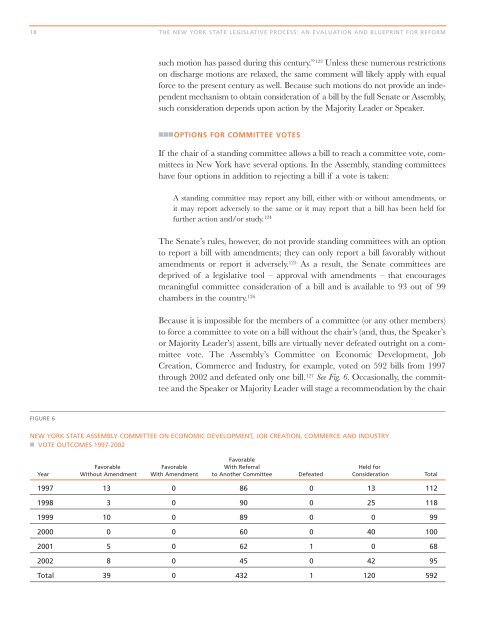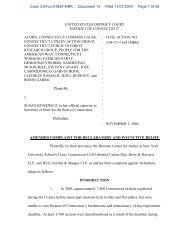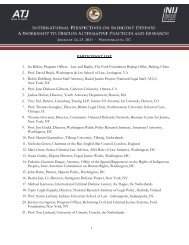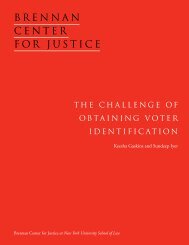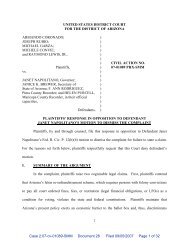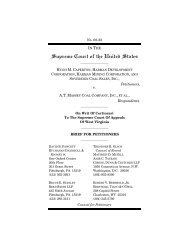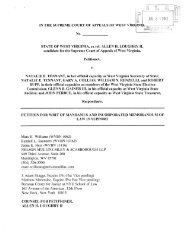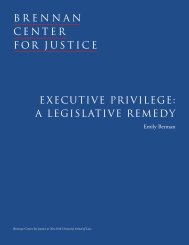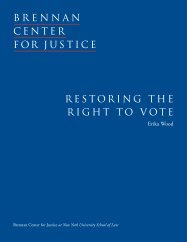THE NEW YORK STATE LEGISLATIVE PROCESS: AN ...
THE NEW YORK STATE LEGISLATIVE PROCESS: AN ...
THE NEW YORK STATE LEGISLATIVE PROCESS: AN ...
Create successful ePaper yourself
Turn your PDF publications into a flip-book with our unique Google optimized e-Paper software.
18 <strong>THE</strong> <strong>NEW</strong> <strong>YORK</strong> <strong>STATE</strong> <strong>LEGISLATIVE</strong> <strong>PROCESS</strong>: <strong>AN</strong> EVALUATION <strong>AN</strong>D BLUEPRINT FOR REFORM<br />
FIGURE 6<br />
such motion has passed during this century.” 123 Unless these numerous restrictions<br />
on discharge motions are relaxed, the same comment will likely apply with equal<br />
force to the present century as well. Because such motions do not provide an independent<br />
mechanism to obtain consideration of a bill by the full Senate or Assembly,<br />
such consideration depends upon action by the Majority Leader or Speaker.<br />
■■■OPTIONS FOR COMMITTEE VOTES<br />
If the chair of a standing committee allows a bill to reach a committee vote, committees<br />
in New York have several options. In the Assembly, standing committees<br />
have four options in addition to rejecting a bill if a vote is taken:<br />
A standing committee may report any bill, either with or without amendments, or<br />
it may report adversely to the same or it may report that a bill has been held for<br />
further action and/or study. 124<br />
The Senate’s rules, however, do not provide standing committees with an option<br />
to report a bill with amendments; they can only report a bill favorably without<br />
amendments or report it adversely. 125 As a result, the Senate committees are<br />
deprived of a legislative tool – approval with amendments – that encourages<br />
meaningful committee consideration of a bill and is available to 93 out of 99<br />
chambers in the country. 126<br />
Because it is impossible for the members of a committee (or any other members)<br />
to force a committee to vote on a bill without the chair’s (and, thus, the Speaker’s<br />
or Majority Leader’s) assent, bills are virtually never defeated outright on a committee<br />
vote. The Assembly’s Committee on Economic Development, Job<br />
Creation, Commerce and Industry, for example, voted on 592 bills from 1997<br />
through 2002 and defeated only one bill. 127 See Fig. 6. Occasionally, the committee<br />
and the Speaker or Majority Leader will stage a recommendation by the chair<br />
<strong>NEW</strong> <strong>YORK</strong> <strong>STATE</strong> ASSEMBLY COMMITTEE ON ECONOMIC DEVELOPMENT, JOB CREATION, COMMERCE <strong>AN</strong>D INDUSTRY<br />
■ VOTE OUTCOMES 1997-2002<br />
Favorable<br />
Favorable Favorable With Referral Held for<br />
Year Without Amendment With Amendment to Another Committee Defeated Consideration Total<br />
1997 13 0 86 0 13 112<br />
1998 3 0 90 0 25 118<br />
1999 10 0 89 0 0 99<br />
2000 0 0 60 0 40 100<br />
2001 5 0 62 1 0 68<br />
2002 8 0 45 0 42 95<br />
Total 39 0 432 1 120 592


